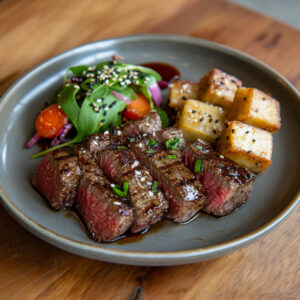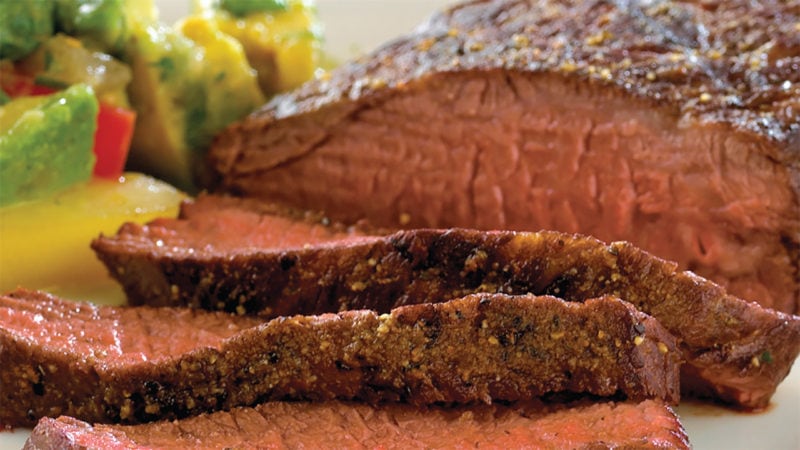Last Updated on September 29, 2020
Everything old is new again, as the saying goes. But that shouldn’t stop you from eating some of the “new cuts” of beef that you can find across the United States these days.
Witness the Denver steak, one of the recently “discovered” beef cuts that, if you are lucky, you can find on the menu at some of the best purveyors of meat across the country. (You can also sometimes get the Denver steak as part of a monthly ButcherBox subscription.)
While the profession of “butcher” has been around likely as long as cattle have been domesticated — and the oldest butcher guild in England was founded in the tenth century — the Denver cut is less than a decade old.
What is a Denver Steak?
So, what exactly is a Denver steak?
The cut comes from the chuck roll, which is mostly muscular meat from the area that starts under the shoulder blade and continues to the ribs and backbone. Some common steaks that derive from this area include the ribeye and Delmonico steaks.
More specifically, the Denver steak comes from the serratus ventralis section of the chuck underblade. Most of the cuts derived from the underblade area are tough and tend to be used for ground beef and stew meat.
But the Denver steak is an exception.
Getting a Denver steak out of the chuck roll is a bit of an onerous process. It usually comes from a section that accounts for only eight total pounds of an average 25-pound chuck roll. The cut is a part of the muscle that is more flavorful, due to marbling, and more tender than the surrounding meat. This section of the shoulder underblade gets a lot of use, but the particular area that derives the Denver steak is one often used less and therefore has more fat, i.e., marbling. The challenge of making this often tear-shaped cut comes from separating the tough connective tissue surrounding it.
Zabuton and Denver Steak
It is a very rare—as in challenging to find—cut. In fact, before 2009, you couldn’t find a “Denver steak” at all. It didn’t exist. Sort of.
The history of this steak is a bit confusing, as similar cuts of steak appear in other cultures across the world. Their origin, too, is not always clear. For instance, the zabuton is an extremely rare cut of Wagyu steak found in Japan. The name, which in Japanese means “flat cushion,” refers to the shape it is often presented in. This cut is often sliced extremely thin and cooked for a very short period of time—about eight seconds.
Similar cuts from the same region of a cow can be found throughout the world, yet, as far as we’ve found, few are promoted as a steak meant to be thrown on the grill and cooked. The key modifier in the previous sentence being “promoted,” as you will see below.
From the Rockies? How the Denver Steak Got Its Name
The Denver steak has its origins in a project funded by the Cattleman’s Beef Board called the Beef Checkoff Program. The goal of The Beef Checkoff Program is to identify and promote new and potentially more affordable cuts of meat. The Denver steak is the result of a research project from the 1990’s by meat-science professors at the University of Florida and the University of Nebraska.
The moniker “Denver steak” has no historical significance; it is not as if the cut is more popular in the Rocky Mountain foothills. It is actually the marketing brainchild of Beef Checkoff Program and was “unveiled” with the cut in 2009.
So, in more ways than one, the Denver steak—both an innovation and a bit of a beef industry marketing effort—is a most American creation.
One last thing to know about the Denver steak: Among the thousands of cuts identified during the research project that led to the discovery of the cut, the Denver steak is the fourth most tender muscle section of the animal.
You will undoubtedly discover this once you take your first bite of the tender cut.
Cooking a Denver Steak
According to most —but not all—chefs, the best way to cook a Denver steak is to do so rather quickly on a very hot grill. The key to a great Denver steak experience, however, is how you slice this particular cut.
As we’ve pointed out before, how you cut your steak can have a tremendous impact on taste and tenderness; cutting the wrong way and you will make a potentially delectable steak tough and less flavorful.
This is especially true for a Denver steak. Like many other muscular cuts, it should be cut against the grain for maximum taste and tenderness. Now you know more about the cut, get out there and throw one on the grill.
Want a great Denver steak recipe? Check out one of our favorites below:

Ingredients
- 1 pkg ButcherBox Denver Steak
- ⅔ c miso
- ⅓ c mirin
- ⅓ c rice wine
- 4 cloves garlic
- 1 Tbsp fresh ginger grated
Miso Carrots
- 6 ea carrots cut into ¼” slices
- 2 c orange juice
- ¼ c miso
- 1 ea orange zested
Instructions
- Preheat immersion circulator water bath to 135°F
- Place Denver Steaks in heavy duty freezer bag. Add miso, mirin, rice wine, garlic and ginger
- Seal bag halfway and slowly immerse in water bath, allowing air to escape. Seal completely and cook for 8 hours.
- Remove from water bath and let rest in juices for at least 10 minutes.
- Preheat skillet and sear on all sides, for 2 minutes per side.
- Slice thinly against the grain.
Miso Carrots
- Place sliced carrots, orange juice and miso in saucepan.
- Simmer on low heat until tender.
- Drain carrots and reserve ½ c of liquid.
- Place carrots back in pan and sauté until caramelized. Add reserved carrot liquid and cook 3 more minutes or until liquid is nearly gone.
- Toss carrots with orange zest.
Dennis Keohane is a writer, editor, and former Editorial Director for ButcherBox with a passion for storytelling and food. Combining his love for high-quality ingredients with engaging narratives, he crafts content that inspires home cooks to explore new flavors, techniques, and the joy of cooking.



